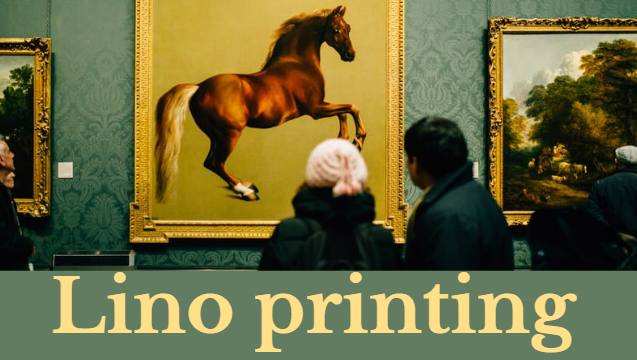An Overview of Lino Printing
Lino printing is a decades-old technique of relief printing that is both adaptable and easily accessible. It started out as a simpler alternative to woodcut printing and has grown to be a popular method among printmakers and artists alike. The history, materials, methods, and current applications of Lino printing are all examined in this article.
The origins of Lino printing
Also known as linocut printing, can be traced back to the early 20th century, when it emerged as a Lino Printing less expensive alternative to woodcut printing. A relief surface is created by carving into linoleum sheets that are typically mounted on a wood block. To transfer the image, Lino Printing a roller is used to ink this surface before it is pressed onto paper or fabric.
The creation of tile as a deck material during the nineteenth century made ready for its utilization in printing. In the early 1900s, lino printing was made popular by artists like Pablo Picasso and Henri Matisse because of its ability to produce bold lines and simplified shapes.
Lino printing became a preferred printing
Due to its low cost and ease of use, lino printing became a preferred printing method over the subsequent decades. As a vibrant art form with a long history of experimentation and innovation, it continues to thrive today.
Also Read : Scott Dylan London
Materials and Equipment Artists
Require the following essential materials and equipment to practice lino printing Linoleum Carving is primarily done with this material. It is available in sheets or blocks and a variety of thicknesses and textures. The creation of tile as a deck material during the nineteenth century made ready for its utilization in printing. In the early 1900s, lino printing was made popular by artists like Pablo Picasso and Henri Matisse because of its ability to produce bold lines and simplified shapes.
Making Equipment
Linoleum is carved with lino cutting tools, also known as gouges or blades. Artists can use Lino Printing these tools to draw intricate details or broad strokes because they come in a variety of sizes and shapes. The creation of tile as a deck material during the nineteenth century made ready for its utilization in printing. In the early 1900s, lino printing was made popular by artists like Pablo Picasso and Henri Matisse because of its ability to produce bold lines and simplified shapes.
Ink blocks and a variety Lino Printing
Lino printing typically makes use of relief printing ink that is based on water. It is suitable for a variety of printing methods and comes in a variety of colors and viscosities.The creation of tile as a deck material during the nineteenth century made ready for its utilization in printing. In the early 1900s, lino printing was made popular by artists like Pablo Picasso and Henri Matisse because of its ability to produce bold lines and simplified shapes.
Brayer, or Ink Roller
To evenly apply ink to the surface of the carved linoleum, this tool is used. Brayers come in a variety Lino Printing of sizes to accommodate a variety of print textures and sizes. Printing on Fabric or Lino Printing Paper. Depending on the desired effect and application, artists can print on a variety of papers or fabrics.
Press for Lino Printing printing (optional)
Even though it is not necessary, a printing Lino Printing press can make the printing process easier by providing consistent pressure and results. The creation of tile as a deck material during the nineteenth century made ready for its utilization in printing. In the early 1900s, lino printing was made popular by artists like Pablo Picasso and Henri Matisse because of its ability to produce bold lines and simplified shapes.
Methods for Lino Printing Printing in Relief
Lino printing’s fundamental method is this one. The printed image is produced because the carved linoleum surface’s raised areas hold ink while the recessed areas do not. The creation of tile as a deck material during the nineteenth century made ready for its utilization in printing. In the early 1900s, lino printing was made popular by artists like Pablo Picasso and Henri Matisse because of its ability to produce bold lines and simplified shapes.
Printing at a lower rate Lino Printing
A single linoleum block is used to create a multicolored print, which is also known as the reduction method. Between each color application, the block Lino Printing is gradually removed, making it impossible to recreate the print once the edition is finished.
Printing in multiple blocks Lino Printing
Multi-block printing, in contrast to reduction printing, employs distinct linoleum blocks Lino Printing for each color. As a result, color placement and layering are more adaptable. The creation of tile as a deck material during the nineteenth century made ready for its utilization in printing. In the early 1900s, lino printing was made popular by artists like Pablo Picasso and Henri Matisse because of its ability to produce bold lines and simplified shapes.
Embossing Lino Printing
Artists can create Lino Printing embossed effects by printing without ink, where the texture of the linoleum block is imprinted onto the paper. The creation of tile as a deck material during the nineteenth century made ready for its utilization in printing. In the early 1900s, lino printing was made popular by artists like Pablo Picasso and Henri Matisse because of its ability to produce bold lines and simplified shapes.
Collagraphy to Lino Printing
This method combines relief Lino Printing printing with collage by first printing on linoleum and then adding textured materials like fabric or cardboard to the block. The creation of tile as a deck material during the nineteenth century made ready for its utilization in printing. In the early 1900s, lino printing was made popular by artists like Pablo Picasso and Henri Matisse because of its ability to produce bold lines and simplified shapes.
How to Make a Lino Printing
- Preparation and design: Before transferring their design onto the linoleum block, artists Lino Printing begin by sketching it on paper. Planning the composition and considering the image’s reverse appearance when printed are crucial at this stage.
- Carving: Artists remove the parts of the linoleum block that they do not want printed with Lino Printing lino cutting tools. To achieve the desired line thickness and detail, this requires precision and control.
- Inking: Artists use a Lino Printing brayer to evenly apply ink to the block after it has been carved. They wipe away any excess ink to ensure that it only covers the raised areas of the block.
- Printing: Artists use a printing press or a handheld tool like a barren or wooden Lino Printing spoon to evenly apply pressure to the surface of the inked block while placing it face down on paper or fabric. The print will retain all of the block’s textures and details if it is handled with care.
- Finishing and drying: The artwork is Lino Printing left to dry completely after being printed. Depending on their artistic vision, artists can hand-color prints or leave them as they are.
Applications and Artists Today Lino printing
Continues to be a source of inspiration for contemporary artists all over the world because it combines tradition and innovation in a novel way The Arts Lino printing is a technique that a lot of artists use to make original prints and limited editions. People who want to learn about texture, color, and form will enjoy its tactile quality and expressive potential. Lustration Due to its ability to produce images that are both bold and graphic, lino printing is also popular among illustrators. It is used to convey narrative and mood in book illustrations, posters, and editorial art.
Fabric Design Lino printing
Lino printing has recently found use in the design of textiles. It is used by artists and designers to create fabric patterns and motifs, giving fashion and interior design a handcrafted feel. Education and community: In order to introduce students and enthusiasts to the joys of printmaking, lino printing workshops and classes are held worldwide in art centers and educational institutions. This encourages experimentation with the medium and fosters a sense of community among artists.
Conclusion
Lino printing is a dynamic and approachable form of art with a long and relevant history. It started out as a simple alternative to woodcut printing and has since developed into a versatile medium that artists love for its expressive potential and tactile qualities. Lino printing continues to captivate with its capacity to transform concepts into vivid printed images, regardless of whether it is used for textile design, illustration, or fine art. Lino printing remains a testament to the enduring appeal of printmaking in the digital age, as artists to experiment with new methods and push the boundaries of the medium.

